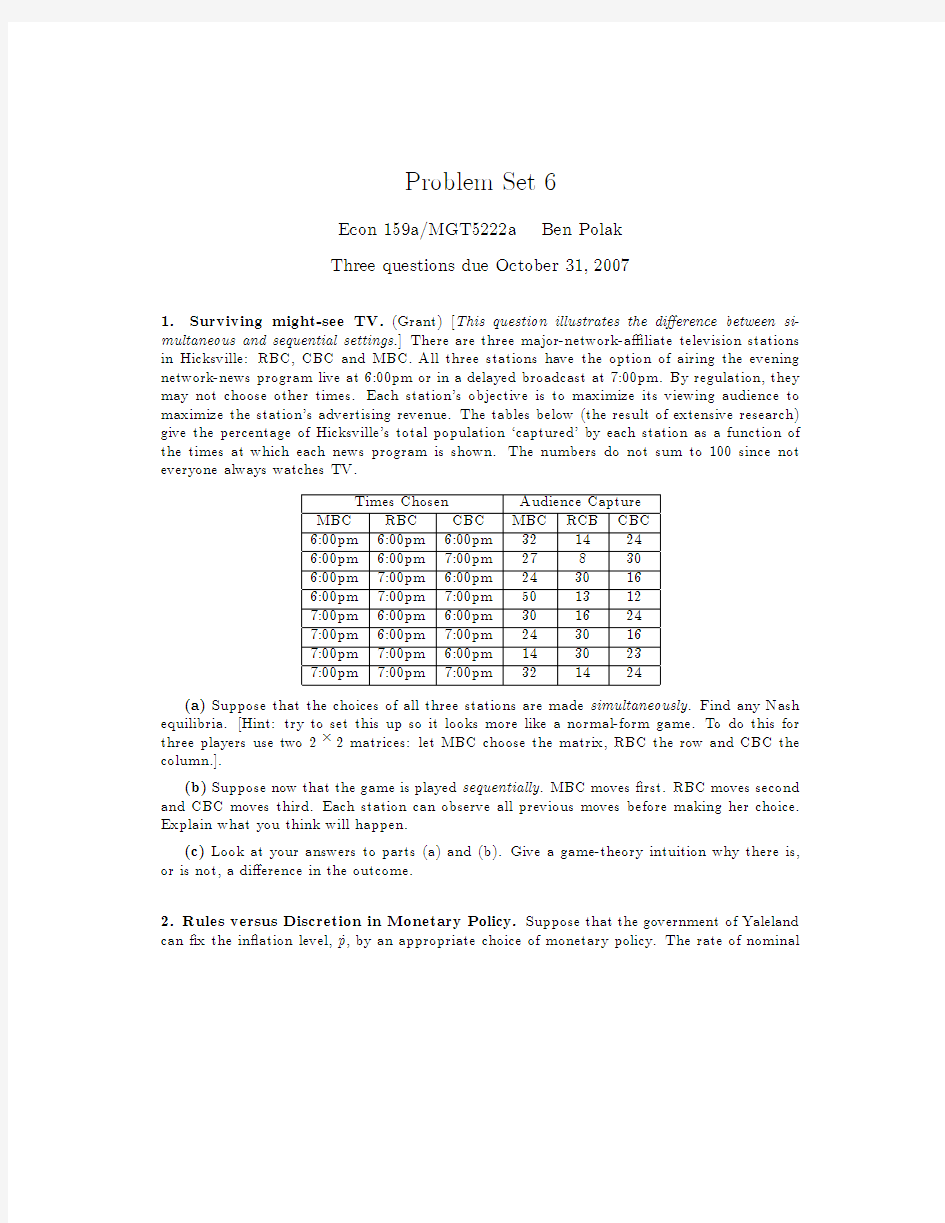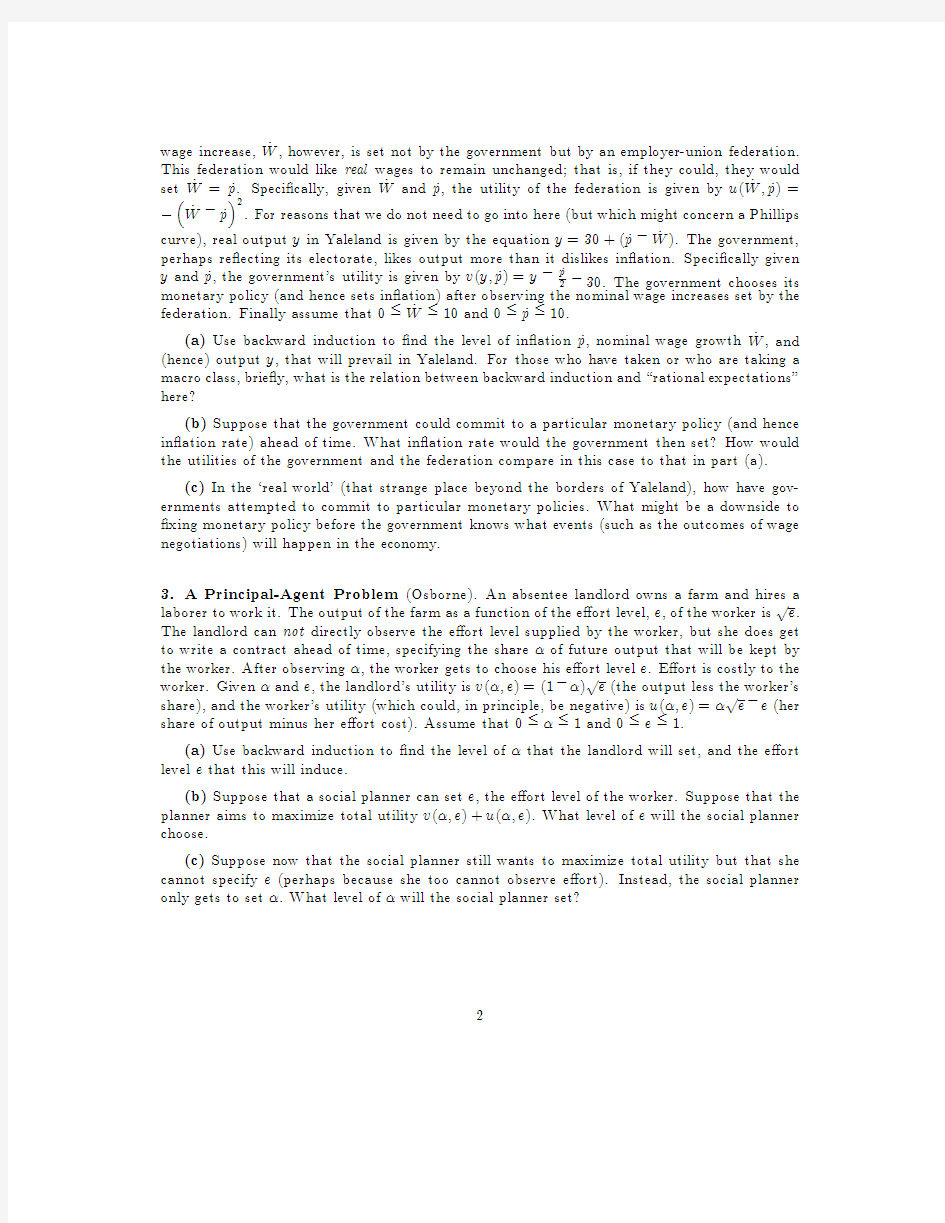problemset6


Problem Set6
Econ159a/MGT5222a Ben Polak
Three questions due October31,2007
1.Surviving might-see TV.(Grant)[This question illustrates the di erence between si-multaneous and sequential settings.]There are three major-network-a liate television stations in Hicksville:RBC,CBC and MBC.All three stations have the option of airing the evening network-news program live at6:00pm or in a delayed broadcast at7:00pm.By regulation,they may not choose other times.Each station's objective is to maximize its viewing audience to maximize the station's advertising revenue.The tables below(the result of extensive research) give the percentage of Hicksville's total population`captured'by each station as a function of the times at which each news program is shown.The numbers do not sum to100since not everyone always watches TV.
Times Chosen Audience Capture
MBC RBC CBC MBC RCB CBC
6:00pm6:00pm6:00pm321424
6:00pm6:00pm7:00pm27830
6:00pm7:00pm6:00pm243016
6:00pm7:00pm7:00pm501312
7:00pm6:00pm6:00pm301624
7:00pm6:00pm7:00pm243016
7:00pm7:00pm6:00pm143023
7:00pm7:00pm7:00pm321424
(a)Suppose that the choices of all three stations are made simultaneously.Find any Nash equilibria.[Hint:try to set this up so it looks more like a normal-form game.To do this for three players use two2 2matrices:let MBC choose the matrix,RBC the row and CBC the column.].
(b)Suppose now that the game is played sequentially.MBC moves rst.RBC moves second and CBC moves third.Each station can observe all previous moves before making her choice. Explain what you think will happen.
(c)Look at your answers to parts(a)and(b).Give a game-theory intuition why there is, or is not,a di erence in the outcome.
2.Rules versus Discretion in Monetary Policy.Suppose that the government of Yaleland can x the in ation level,_p,by an appropriate choice of monetary policy.The rate of nominal
wage increase,_W,however,is set not by the government but by an employer-union federation.
This federation would like real wages to remain unchanged;that is,if they could,they would
set_W=_p.Speci cally,given_W and_p,the utility of the federation is given by u(_W;_p)= _W _p 2.For reasons that we do not need to go into here(but which might concern a Phillips curve),real output y in Yaleland is given by the equation y=30+(_p _W).The government,
perhaps re ecting its electorate,likes output more than it dislikes in ation.Speci cally given
y and_p,the government's utility is given by v(y;_p)=y _p
2 30.The government chooses its monetary policy(and hence sets in ation)after observing the nominal wage increases set by the
federation.Finally assume that0 _W 10and0 _p 10.
(a)Use backward induction to nd the level of in ation_p,nominal wage growth_W,and
(hence)output y,that will prevail in Yaleland.For those who have taken or who are taking a
macro class,brie y,what is the relation between backward induction and\rational expectations"
here?
(b)Suppose that the government could commit to a particular monetary policy(and hence
in ation rate)ahead of time.What in ation rate would the government then set?How would
the utilities of the government and the federation compare in this case to that in part(a).
(c)In the`real world'(that strange place beyond the borders of Yaleland),how have gov-
ernments attempted to commit to particular monetary policies.What might be a downside to
xing monetary policy before the government knows what events(such as the outcomes of wage
negotiations)will happen in the economy.
3.A Principal-Agent Problem(Osborne).An absentee landlord owns a farm and hires a
laborer to work it.The output of the farm as a function of the e ort level,e,of the worker is p e. The landlord can not directly observe the e ort level supplied by the worker,but she does get to write a contract ahead of time,specifying the share of future output that will be kept by the worker.After observing ,the worker gets to choose his e ort level e.E ort is costly to the worker.Given and e,the landlord's utility is v( ;e)=(1 )p e(the output less the worker's share),and the worker's utility(which could,in principle,be negative)is u( ;e)= p e e(her share of output minus her e ort cost).Assume that0 1and0 e 1.
(a)Use backward induction to nd the level of that the landlord will set,and the e ort
level e that this will induce.
(b)Suppose that a social planner can set e,the e ort level of the worker.Suppose that the
planner aims to maximize total utility v( ;e)+u( ;e).What level of e will the social planner
choose.
(c)Suppose now that the social planner still wants to maximize total utility but that she
cannot specify e(perhaps because she too cannot observe e ort).Instead,the social planner
only gets to set .What level of will the social planner set?
2
